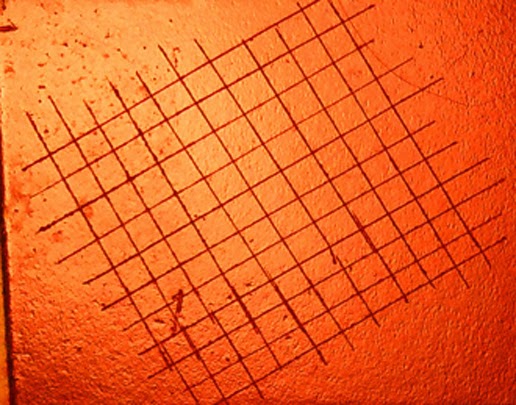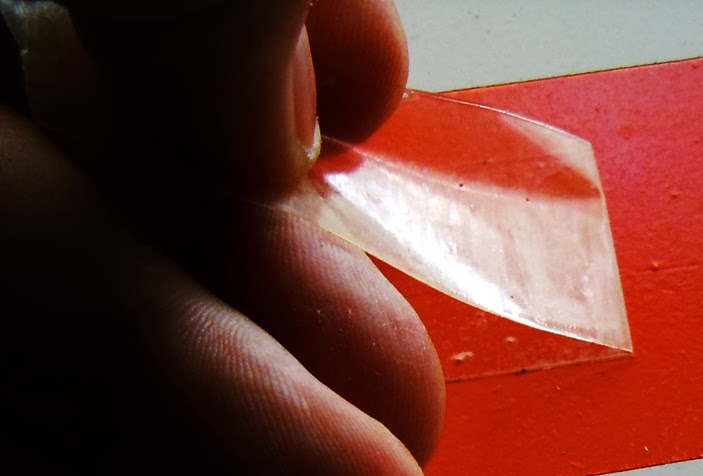Intercoat adhesion refers to either the bond of a primer coat to a substrate, or to the adhesion of one coating to another. In many cases, a primer or top coat bonds to the primer or another coating mechanically. Although you may not see microscopic imperfections on a surface, a primer or paint will grip onto these rough areas.
You can generally improve adhesion by lightly sanding a surface or scuffing it with a ScotchBrite® pad, which puts tiny scratches on it. The rule of thumb is that the deeper scratch profile, the better the bond. One advantage of using ScotchBrite® pad instead of sandpaper, it that it creating a deep scratch without removing much material.
For scuffing a surface, such as aluminum composite material, a red ScotchBrite® pad is generally recommended. To ensure good surface adhesion, scuff the surface until the entire surface is dull with no shiny areas.
Another way that a coating can adhere to another coating is chemical adhesion. Ingredients in the paint chemistry can improve the flow out of a coating allowing it to better penetrate a porous surface. In addition, solvents in a coating can partially solvate another coating causing it to bite into its surface and improving the bond between coating layers.
Causes of Intercoat Adhesion Failure
The roughness of a surface and the chemistries of the primer and top coats are just two of many aspects affecting intercoat adhesion. Other factors include:
● Moisture retention in a porous substrate which could potentially result in blistering of the coating
● Substrate contamination
● Failure to apply a coating within its specified application temperature range
● Incompatibility of primers and paints
● Applying a coating before an earlier coating has fully cured.
Ensuring Good Intercoat Adhesion and Preventing Failure.
Read the product specification sheets and technical bulletins for the coatings that you use. Make sure that you prime, paint and clear coat according to the manufacturer’s recommendations. As a general rule, do not mix and match your materials. Stick with the products produced within one manufacturer’s paint system to ensure that components are matched for compatibility.
Intercoat Adhesion Tests.
Before using a new substrate, a new primer, paint or clear coat or trying a new production procedure, my recommendation is to “Test, Don’t Guess”. Make sure that when you try something new, accurately record what you did so you can duplicate your results.
Some of the tests that you can use to evaluate materials and procedures are the ones that I learned in the screen print industry for evaluating good intercoat adhesion of many coatings on various media. These tests include the scratch test, tape test and cross hatch test.
While some sophisticated lab equipment has been developed to evaluate intercoat adhesion, a shop can easily evaluate a coating using the following procedures:
Thumb Nail or Scratch Test.
You can’t perform a more elemental test for ink adhesion than a scratch test, also referred to as a thumb nail test. Although many technicians scoff at this procedure for its simplicity, it is nevertheless a quick and easy go/no go check. Here’s how it works.
After printing or painting some sample pieces of film or substrate, allow the coating to completely cure. In conducting these tests, you should cure the coating using the same method as will be used in production.
Screen printers will simply scratch the surface of the ink with your thumbnail. A properly cured ink will resist scratching. Painters will do a variation of this test, scraping the coating with the blade of a utility knife.
Thumb Twist Test.
Another simple test is the thumb twist test. In this test, just press your thumb against the ink or paint and give it a twist. If the ink is not thoroughly cured, a hardened layer of ink can slip over an uncured layer of ink. A properly cured coating also should not feel tacky. Instead it should feel dry to the touch.
Although the Thumb Twist and the Thumbnail test methods are regarded by some as being very subjective in nature and dependent on the skill and experience of the individual, these tests can alert printers to potential adhesion problems.
Cross Hatch Test.
Your testing should include a cross hatch test to check the adhesion of the ink to the substrate; intercoat adhesion (the bond of one layer of a coating to another) and compatibility of the coating with the substrate or another coating.
The cross hatch test consists of lightly scoring the printed ink sample or paint sample eleven times with an X-Acto® knife and then scoring the ink again the same number of times over the first set of lines at a 90° angle. The cross hatch pattern of parallel lines should be approximately 1/8” (.32 cm) apart. For about $500 or $600 you can also buy a cross hatch tester. This tools has blades evenly spaced and at a uniform depth.

Using an X-Acto knife lightly cut cross hatch lines at a 90° angle forming a grid.
After cutting the lines, use a plastic squeegee to burnish an aggressive tape, such as 3M Brand #600 clear tape, over the scored cutlines. The tape is then pulled off 180° against itself, in one quick motion. If any of the ink comes off, the adhesion of the ink to the substrate is insufficient.

Burnish an aggressive tape over the scored cutlines. Then pull the tape off in one quick motion at a 180° angle against itself .
A variation of the cross hatch test is the Cross Cut or Tape Test. Using an X-Acto® knife you lightly score the surface with two knife cuts forming an “X”. After applying an aggressive tape over the cut and quickly ripping it from the surface at a 180° angle against itself, you should check the substrate and the tape for any paint or ink, which may have been removed. This test checks whether the coating is secure to the surface. Coatings, which have not formed a strong bond, are prone to peeling.
Conclusion
You can generally evaluate the performance of coatings a few days after they have cured. Manufacturers will often specify in their product literature when you should conduct product tests.
In most cases, as time goes on, adhesion to the substrate and between coating layers increases. Be aware though, that in some cases, intercoat adhesion can decrease with the passage of time.



